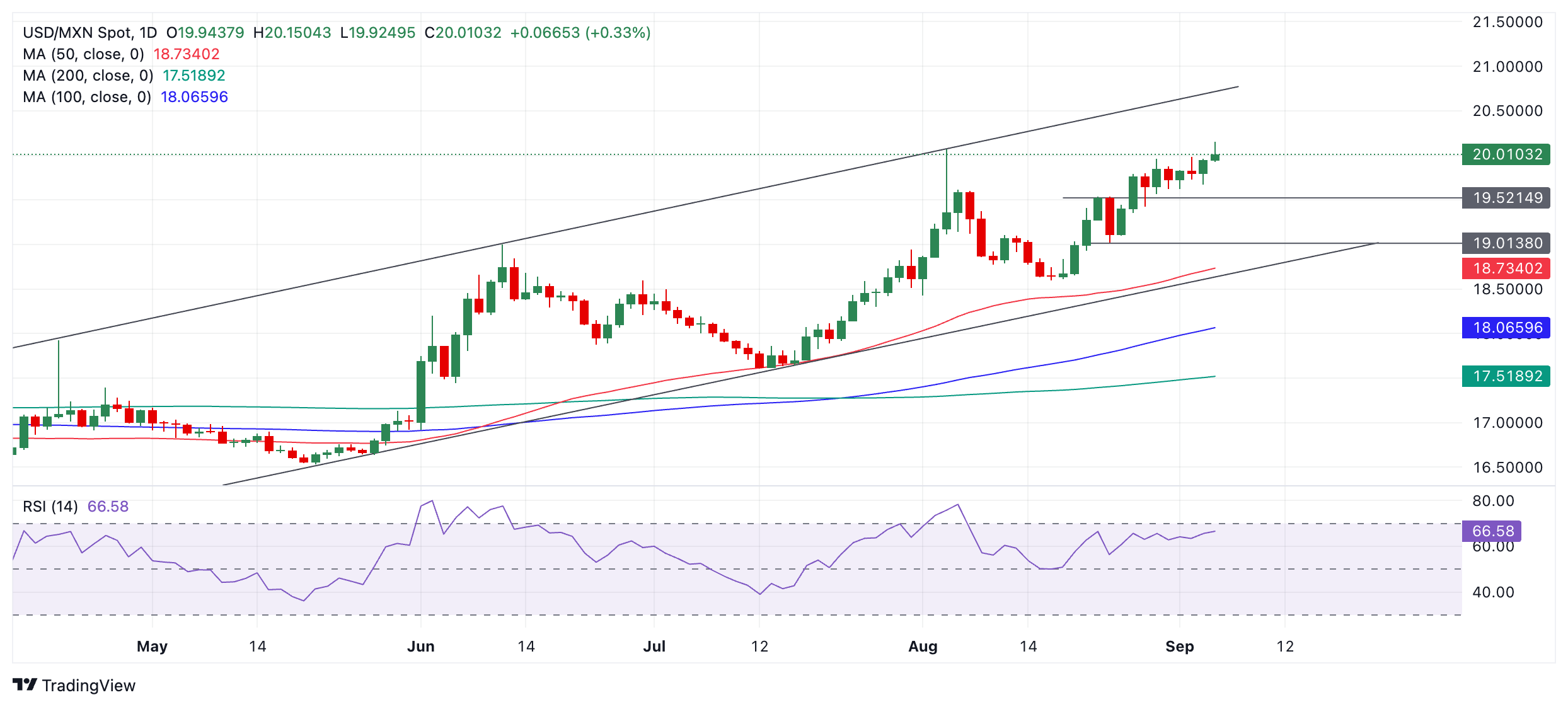Most recent article: Mexican Peso sinks to four-week low as judicial reform spurs sell-off
- The Mexican Peso weakens after the Mexican lower house votes through a set of controversial reforms.
- Investors are concerned about the negative impact of the reforms on the economy.
- USD/MXN restarts its uptrend after a pause and breaks above 20.00.
The Mexican Peso (MXN) depreciates in its most-traded pairs on the day named after the Norse god of thunder, extending the over-one-percent decline clocked up on Wednesday.
The Peso is being sold because investors are fretting about the Mexican parliament passing a controversial bill of reforms that critics say will compromise the independence of the judiciary, undermine democracy and damage international trade and foreign investment.
Mexican Peso depreciates after Mexican congress passes reforms
The Mexican Peso weakened in its key pairs on Wednesday after lawmakers in Mexico’s lower house voted through a controversial bill of reforms to the judiciary.
The reforms seek to counter the perceived corruption in the judiciary by electing judges through popular vote, rather than by appointment. However, critics argue the bill will compromise the independence of judges and fail to combat corruption, which is more located amongst lower-ranking officials and members of law enforcement agencies.
Despite protests and strikes from court employees against the reforms, who blocked the entrance to congress on Wednesday – forcing lawmakers to relocate to a sports hall for the debate and subsequent vote – the government managed to get the bill passed, winning a vote of 357 in favor versus 130 against.
The reforms will now be debated in Mexico’s upper house, where the government is one seat short of a majority. Most experts believe, however, that it will still get voted through.
From a financial perspective, the reforms run the risk of leading to a decline in foreign investment. This, in turn, would reduce demand for the Peso, leading to a further depreciation of the currency.
The US ambassador for Mexico, Ken Salazar, said that although reforms to the judiciary were needed the current bill was raising concerns among investors in his country. He warned it could jeopardize the two countries’ close relationship, which includes a free trade deal.
“If it is not done in the right way, it could cause a lot of damage to the relationship,” said Salazar at a press conference on Tuesday.
At the time of writing, one US Dollar (USD) buys 20.00 Mexican Pesos, EUR/MXN trades at 22.20, and GBP/MXN at 26.34.
Technical Analysis: USD/MXN breaks above 20.00
USD/MXN restarts its uptrend, climbing within a broader rising channel. Given that, according to technical analysis, “the trend is your friend” the odds favor more upside.
On Tuesday, the pair broke briefly above the 19.96 high of the mini-range, making a higher high at 19.98 – on Thursday it breaks above that and touches 20.00.
USD/MXN Daily Chart
This supplies further confirmation of a continuation of the bull trend, with the next target at the upper channel line in the 20.60s.
Mexican Peso FAQs
The Mexican Peso (MXN) is the most traded currency among its Latin American peers. Its value is broadly determined by the performance of the Mexican economy, the country’s central bank’s policy, the amount of foreign investment in the country and even the levels of remittances sent by Mexicans who live abroad, particularly in the United States. Geopolitical trends can also move MXN: for example, the process of nearshoring – or the decision by some firms to relocate manufacturing capacity and supply chains closer to their home countries – is also seen as a catalyst for the Mexican currency as the country is considered a key manufacturing hub in the American continent. Another catalyst for MXN is Oil prices as Mexico is a key exporter of the commodity.
The main objective of Mexico’s central bank, also known as Banxico, is to maintain inflation at low and stable levels (at or close to its target of 3%, the midpoint in a tolerance band of between 2% and 4%). To this end, the bank sets an appropriate level of interest rates. When inflation is too high, Banxico will attempt to tame it by raising interest rates, making it more expensive for households and businesses to borrow money, thus cooling demand and the overall economy. Higher interest rates are generally positive for the Mexican Peso (MXN) as they lead to higher yields, making the country a more attractive place for investors. On the contrary, lower interest rates tend to weaken MXN.
Macroeconomic data releases are key to assess the state of the economy and can have an impact on the Mexican Peso (MXN) valuation. A strong Mexican economy, based on high economic growth, low unemployment and high confidence is good for MXN. Not only does it attract more foreign investment but it may encourage the Bank of Mexico (Banxico) to increase interest rates, particularly if this strength comes together with elevated inflation. However, if economic data is weak, MXN is likely to depreciate.
As an emerging-market currency, the Mexican Peso (MXN) tends to strive during risk-on periods, or when investors perceive that broader market risks are low and thus are eager to engage with investments that carry a higher risk. Conversely, MXN tends to weaken at times of market turbulence or economic uncertainty as investors tend to sell higher-risk assets and flee to the more-stable safe havens.
Information on these pages contains forward-looking statements that involve risks and uncertainties. Markets and instruments profiled on this page are for informational purposes only and should not in any way come across as a recommendation to buy or sell in these assets. You should do your own thorough research before making any investment decisions. FXStreet does not in any way guarantee that this information is free from mistakes, errors, or material misstatements. It also does not guarantee that this information is of a timely nature. Investing in Open Markets involves a great deal of risk, including the loss of all or a portion of your investment, as well as emotional distress. All risks, losses and costs associated with investing, including total loss of principal, are your responsibility. The views and opinions expressed in this article are those of the authors and do not necessarily reflect the official policy or position of FXStreet nor its advertisers. The author will not be held responsible for information that is found at the end of links posted on this page.
If not otherwise explicitly mentioned in the body of the article, at the time of writing, the author has no position in any stock mentioned in this article and no business relationship with any company mentioned. The author has not received compensation for writing this article, other than from FXStreet.
FXStreet and the author do not provide personalized recommendations. The author makes no representations as to the accuracy, completeness, or suitability of this information. FXStreet and the author will not be liable for any errors, omissions or any losses, injuries or damages arising from this information and its display or use. Errors and omissions excepted.
The author and FXStreet are not registered investment advisors and nothing in this article is intended to be investment advice.
Recommended content
Editors’ Picks

AUD/USD stays firm near 0.6300 after strong Chinese exports data
AUD/USD is trading well bid near 0.6300 in Asian trades on Monday, opening the week on the front foot. Risk sentiment remains in a sweeter spot following the weekend's news of lower US tariffs on Chinese electronic supply chain and strong Chinese exports data for March. Tariffs talks will remain on the radar.

USD/JPY recovers to 143.00 amid volatile trading
USD/JPY is trimming losses to retake 143\.00 in Monday's Asian trading. The US Dollar pauses its latest leg down, with traders digesting Trump's tariff news from the weekend. However, the Fed-BoJ policy divergence expectations underpin the Japanese Yen, keeping the weight intact on the pair.

Gold retreats from record highs of $3,245 as US Dollar finds its feet
Gold is rereating from record highs of $3,245 early Monday, extending Friday's late pullback. Reducded demand for safe-havens and a broad US Dollar rebound undermine the yellow metal amid the news of not-so-steep US tariffs on China's semiconductors and electronics.

Bitcoin is on the verge of a breakout while Ethereum and Ripple stabilize
Bitcoin price approaches its key resistance level at $85,000 on Monday; a breakout indicates a bullish trend ahead. Ethereum and Ripple found support around their key levels last week, suggesting a recovery is in the cards.

Is a recession looming?
Wall Street skyrockets after Trump announces tariff delay. But gains remain limited as Trade War with China continues. Recession odds have eased, but investors remain fearful. The worst may not be over, deeper market wounds still possible.

The Best brokers to trade EUR/USD
SPONSORED Discover the top brokers for trading EUR/USD in 2025. Our list features brokers with competitive spreads, fast execution, and powerful platforms. Whether you're a beginner or an expert, find the right partner to navigate the dynamic Forex market.




